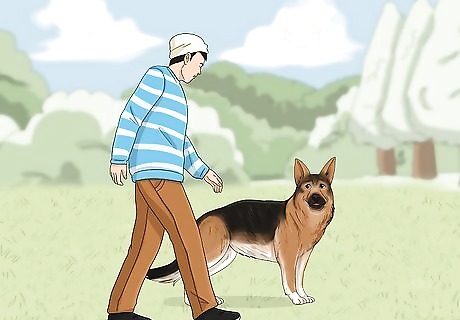
views
Befriending a Strange Dog

Make sure the dog is friendly. When approaching a strange dog, be particularly aware of its body language. If an owner is present, ask the owner if the dog is friendly. Make sure the dog wants to be petted. You can easily alienate a dog by approaching one that is nervous or agitated. A friendly dog is easily noticeable. A friendly dog will wag its tail and approach you to sniff you. Some friendly dogs may not approach directly, but may wag their tails and offer other signs they are friendly. Avoid approaching a dog that's looking you straight in the eyes, barking shrilly, crouching, or growling.

Approach the dog slowly. Even if a dog is friendly, you can easily frighten a dog by approaching too quickly. When approaching a stray dog, do so slowly to assure the dog you're not a threat. You can also wait for the dog to approach you so it's able to build your trust. Crouch down slightly to appear small and not frighten the dog. Only approach a few steps towards the dog. Allow the dog to approach you from there. You can try calling the dog gently.

Get on the dog's level. To assure a strange dog does not see you as a threat, get on the dog's level. Crouch down and let the dog sniff you, wag its tail, and otherwise interact with you. From there, reach your hand out to the dog. Keep your palm up. Allow the dog to sniff you. Keep your hand lower than the dog's head to make sure it feels safe.

Pet and interact with the dog. From here, you can begin petting the dog. Talk to it in a soothing voice as you gently pet and scratch the dog. Avoid patting a dog on the top of the head, as this may come off as aggressive. Always keep your hands level to the dog's head or below the dog's head during early interactions. This assures the dog feels safe with you.

Pay attention to the dog's reactions. You don't want to do anything that will make the dog uncomfortable. Make sure the dog is wagging its tail and calm the whole time. If a dog is uncomfortable, it may back away or even growl or bark. If a dog nudges you with its nose, this is a sign to stop. Dogs will nudge people to let them know something they're doing is bothering them.
Bonding with Your Own Dog

Spend time with your dog. One of the best means of bonding with a dog is simply by interacting with it regularly. If you have a dog, strive to spend time with it. This will improve your relationship with your dog and allow the two of you to bond. Take your dog for walks and play with it regularly. Allow your dog to be near you when you're home. Have your dog sit in the living room with you or sleep next to you on the couch.

Have physical contact with your dog. Dogs are very social animals and respond well to physical contact. A dog that is interacted with physically on a regular basis will generally have a lower stress level than other dogs. Make sure to pet your dog, cuddle your dog, and groom your dog regularly. Pet your dog on a regular basis. Invite your dog up on the couch with you during down time and have a good petting session. If your dog wants to snuggle with you, let it climb on your lap when you read or watch television. Grooming your dog can also be a positive way of bonding. Regular grooming will also keep your dog clean and cut back on bills from groomers. Brush your dog a few times a week. Some dogs may dislike brushing at first, so make sure to brush your dog when it's calm. Reinforce positive behaviors with praise and treats.

Praise positive behavior. Dogs will bond with humans who they see as pack leaders. If a dog respects your authority, this will strengthen your bond. Dogs respond best to positive reinforcement rather than punishment, so work on offering praise and treats when your dog behaves appropriately. Establish a firm routine for your dog. Have things like regular meal times, walk times, and time for playing in the house. When your dog behaves, praise it instead of scolding it. For example, if your dog sits and waits for you to leash it up before a walk, offer verbal praise and even a small treat. This will get you further than scolding your dog for jumping around.

Respect your dog's boundaries. Always be aware of how your dog reacts to something. A positive relationship is built on mutual trust, so do not engage in any behaviors that may distress your dog. If your dog seems nervous about something, cease the behavior. Pay attention to the kinds of things that bother your dog. Your dog may spit out a particular food, for example. It may get scared of loud noises or growl or move away if you pet it a certain way. Try to reduce these kinds of stressors in your dog's life. A happy dog is more likely to bond with its owner. Focus on what your dog responds positively to. Your dog may always roll over for a belly rub, for example. It may love to play tug o' war with you. Try to engage in these behaviors more frequently. This will cause your dog to like you more, increasing the bond between the two of you.

Stay calm, especially with puppies. You need to have patience when bonding with any dog. This is especially true with puppies, as puppies may misbehave more frequently. Remember that dogs take awhile to learn boundaries. If they're behaving in a negative fashion, it's not malicious in nature. Never yell at a dog or strike it physically in any way. This will teach your dog to fear you instead of being your friend.
Avoiding Pitfalls

Learn basic dog body language. In order to assess whether you're successfully befriending a dog, learn basic body language. This way, you can get a better sense of whether your dog does or does not like a particular interaction. A relaxed dog will have its head erect, its ears up, its tail wagging, and its mouth open slightly. A dog may also perk its ears up more if it's excited or playful. Aggressive or frightened dogs will show their teeth and the hair on their tails may stand up. Their tails will also remain stiff. If a dog is scared, it will tuck its tail downward. It will also pull its ears back and duck its head down.

Avoid intimidating gestures. You do not want to inadvertently scare a dog. This will not help you bond. When interacting with a dog, avoid any gestures the dog may read as intimidating. Do not stare a dog directly in the eye. When a dog sniffs your hand, do not move. This could startle a dog.

Handle an aggressive dog appropriately. If a strange dog becomes aggressive, take proper precautions. You want to avoid being bitten. Stop as soon as a dog begins barking or growling and talk to it in a calm, soothing voice. Never turn your back on an aggressive dog. If it pivots around you, keep turning so you're facing the dog. Do not run from an aggressive dog. Wait until the dog stops moving and then slowly back away. Keep your eye on the dog as you move backwards.

Treat each dog you meet as an individual. Remember, no two dogs are the same. You want to treat every dog as an individual and pay attention to its likes and dislikes. Some dogs may love belly rubs, while others may dislike them. Some may love playing fetch, while others may find it stressful. Each time you come across a new dog, pay attention to that dog's specific body language to make sure you're interacting with it in a positive fashion.




















Comments
0 comment